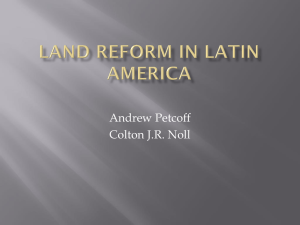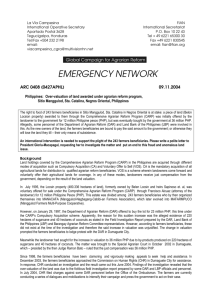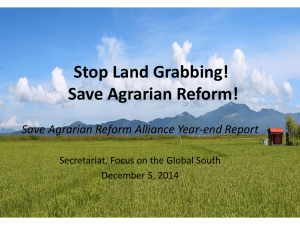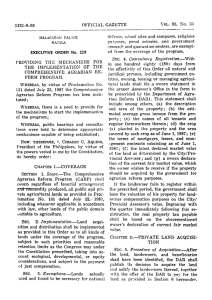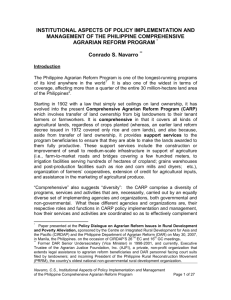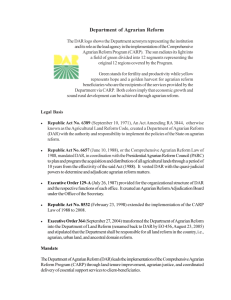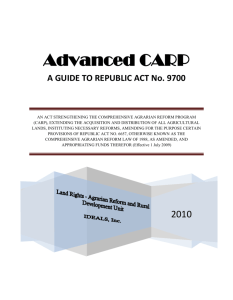Agrarian Reform Remains to be a Promise
advertisement
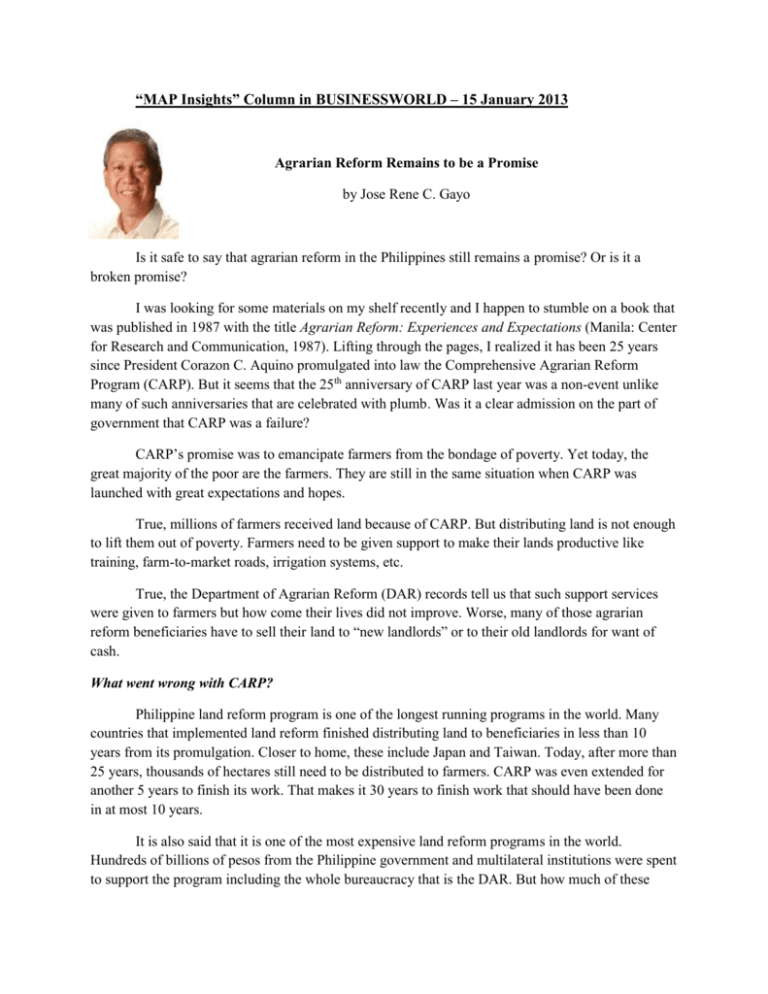
“MAP Insights” Column in BUSINESSWORLD – 15 January 2013 Agrarian Reform Remains to be a Promise by Jose Rene C. Gayo Is it safe to say that agrarian reform in the Philippines still remains a promise? Or is it a broken promise? I was looking for some materials on my shelf recently and I happen to stumble on a book that was published in 1987 with the title Agrarian Reform: Experiences and Expectations (Manila: Center for Research and Communication, 1987). Lifting through the pages, I realized it has been 25 years since President Corazon C. Aquino promulgated into law the Comprehensive Agrarian Reform Program (CARP). But it seems that the 25th anniversary of CARP last year was a non-event unlike many of such anniversaries that are celebrated with plumb. Was it a clear admission on the part of government that CARP was a failure? CARP’s promise was to emancipate farmers from the bondage of poverty. Yet today, the great majority of the poor are the farmers. They are still in the same situation when CARP was launched with great expectations and hopes. True, millions of farmers received land because of CARP. But distributing land is not enough to lift them out of poverty. Farmers need to be given support to make their lands productive like training, farm-to-market roads, irrigation systems, etc. True, the Department of Agrarian Reform (DAR) records tell us that such support services were given to farmers but how come their lives did not improve. Worse, many of those agrarian reform beneficiaries have to sell their land to “new landlords” or to their old landlords for want of cash. What went wrong with CARP? Philippine land reform program is one of the longest running programs in the world. Many countries that implemented land reform finished distributing land to beneficiaries in less than 10 years from its promulgation. Closer to home, these include Japan and Taiwan. Today, after more than 25 years, thousands of hectares still need to be distributed to farmers. CARP was even extended for another 5 years to finish its work. That makes it 30 years to finish work that should have been done in at most 10 years. It is also said that it is one of the most expensive land reform programs in the world. Hundreds of billions of pesos from the Philippine government and multilateral institutions were spent to support the program including the whole bureaucracy that is the DAR. But how much of these ended up in pockets of some government bureaucrats; lawyers and intermediaries who became rich because of overpriced land purchases plus commissions; service providers who made tons of money because of substandard farm-to-market roads, irrigation systems, post-harvest facilities and many others all in the name of the poor farmers? Graft and corruption leaked much of the money away from land reform beneficiaries that could have improved their lives if these were properly spent. Not just “land for the landless” Recently, I had a meeting with one of the officers of the DAR. To my dismay, I learned that DAR does not have programs for education and training for children of land reform beneficiaries. He said that DAR’s mandate is just the farmers themselves. If such is the case, who will take over the farms when the parents die? Our typical Filipino farmer today is 57 years old and with only five years of elementary education. No wonder, our farms are so unproductive! Coupled with that is the lack or absence of serious extension program for land reform beneficiaries. In the case of Japan, South Korea, and Taiwan that successfully implemented land reform, their farmers today enjoy as one the richest farmers in the world. Thanks to education and training programs that gave these farmers access to the latest farming technologies, seed varieties, and postharvest systems that add more value to their agricultural produce. Farmers’ cooperatives were also very critical in providing farmers access to cheaper farm inputs, financing, and marketing intermediation that gave them the opportunity to co-own these various farm enterprises involved in the agribusiness value chain. Is there still hope for land reform beneficiaries? For those who are still tilling their own lands, DAR should implement an educational and training program for children of land reform beneficiaries to prepare them as the future agripreneurs. We can’t do much for the farmers of today because they are already ageing. Money that should be spent training them may as well be spent training their children as the next generation of agripreneurs. Agrarian reform communities may well be advised to consolidate their farm holdings and organize a management company to run these as autonomous agribusiness enterprises. This is precisely what Dole and Del Monte did for the pineapple and banana farming operations after their corporate farms were subjected to CARP. The book that I “discovered” also mentions other modalities where these CARPed lands can be made more productive and produce the incomes needed to make these farmers middle class. These include the following: 1. NUCLEUS ESTATES: It is the production system which has been evolved specifically to meet the needs of developing countries in educating their small farmers and improving the cultivation of standardized crops. There is a collaborative endeavor between a larger enterprise and small landholders. The nucleus is a plantation which can serve as demonstration farm where commercially-tested inputs like seeds, fertilizers and technology are applied. Usually, it also provides the central processing and storage facilities, and does the marketing for the final products. 2. CONTRACT GROWING: The “contractor” under this scheme is either a processor/marketer or a pure trader, and may or may not be extending (but usually does) credit and farm inputs to farmers. 3. COOPERATIVE FARMING: Though cooperatives in the Philippines have not been that successful, some groups that have adopted the cooperative system in farming have shown some success, but rather than production, in cooperative marketing system where farmers still enjoy complete independence on how they grow the crops bond themselves together in marketing their produce. Maybe DAR should revisit its position and be open to such arrangements by acting as facilitator between agrarian reform beneficiaries by way of consolidating land holdings and encouraging investors to enter into joint venture or contract growing schemes. The question now is: Will the son fulfill the promise made by his mother 25 years ago to free the farmers from the bondage of poverty? P-Noy still has three and a half years as President and if he puts the same passion weeding out corruption in government to making rural development happen, that promise may still be fulfilled. (This article reflects the personal opinion of the author and does not reflect the official stand of the Management Association of the Philippines. The author is Vice Chair of the MAP Agribusiness and Countryside Development Committee, and Dean of the MFI Farm Business School. Feedback at map@globelines.com.ph. For previous articles, please visit www.map.org.ph)

